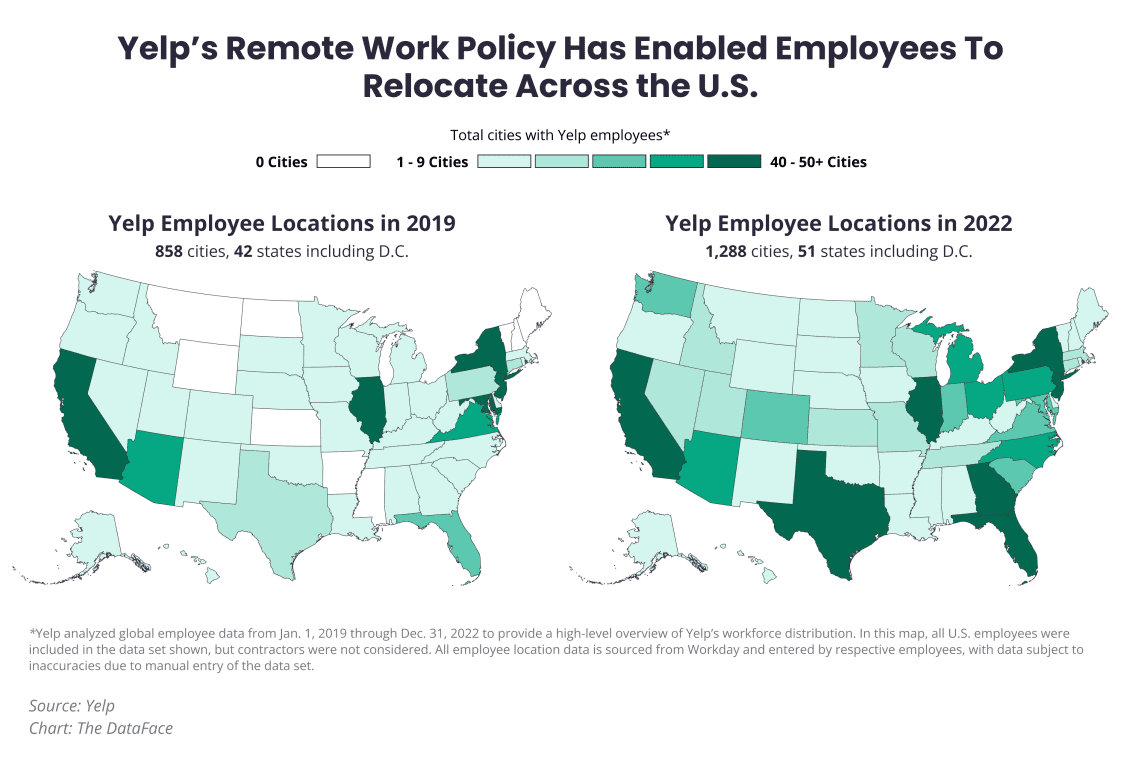Why remote work is right for Yelp
The tech company’s CPO Carmen Whitney Orr shares all.
Why You Should Care
Yelp is a on a mission to 'be un-boring'.
Central to this is experimenting and really listening to employee feedback around flexible and remote work.
Find out why being remote-first has brought the tech company huge success!
Since 2004, Yelp has been enabling millions of individuals across the world to review and rate their experience in stores, restaurants, hotels, pretty much any brick-and-mortar location.
The IT company helped put the consumer back in the driving seat, and helped place customer experience at the top of mind for businesses, big and small.
But Yelp isn’t just laser focused on its users’ experience as they go out about their day-to-day lives, it is also on a mission to ensure its workforce of 3,000 people has a fantastic employee experience.
And, for Yelp, core to having engaged, happy, motivated workers is flexibility. This explains why Yelp decided post-COVID-19 to shift from in-person work five-days a week, to being remote-first.
UNLEASH sat down with chief people officer Carmen Whitney Orr to find out why this is the right approach for Yelp as both a business and an employer.
Yelp becomes remote-first
In 2019, before COVID-19 became part of the global vernacular, the tech company’s employees were primarily based in eight cities across the US, and they predominantly worked in offices in those locations five-days a week.
Then the pandemic hit in March 2020, and Yelp quickly made the shift to remote work. All employees were given laptops and other essential IT equipment; they could also claim a stipend to cover their home office set up, and their internet and phone bills.
Yelp found that once its employees had found their footing, they were able to work productively and successfully while distributed.
Therefore, in early 2021, Yelp’s C-Suite and HR team decided to not set a return to office date, and instead pilot a remote-first approach, explains Orr.
Although employees had the option to go and work at any of Yelp’s eight offices, “we found that employees voted with their feet, with only 1% choosing to come into the office every day”.
This makes sense as Yelp internal data shows that many of its workers had physically moved away from their offices – there was a 50% increase in the number of cities that employees worked in, and a particular decline of employee population in San Francisco (70%), New York, Washington and Chicago (67%).

Credit: Yelp.
2021 rolled into 2022, and Yelp decided to ask its employees about their views on remote work. The results were clear – 86% said they would prefer to work remotely most or all the time, 87% said remote work made them more effective and 93% said they were able to meet their goals while working remotely.
Orr explains: “We looked at this employee feedback, as well as our strong business performance, and decided to move forward with closing our most consistently underutilized offices in New York, Chicago and Washington DC, as well as reducing our footprint in Phoenix”.
Yelp has also since moved to reduce its office footprint in San Francisco.
Ultimately, the June 2022 decision made Yelp’s remote-first pilot permanent, but Orr explains that “some of our employees choose to work from our offices” in San Francisco, Phoenix, Toronto, London and Hamburg.
For Orr, this remote-first commitment exemplifies Yelp’s core value to ‘be un-boring’. It really stood out to her when she took on the Yelp CPO role in January 2022.
“A key part of my role at Yelp is to lead the transformation of how we work – to do that you have to have a leadership team that is willing to challenge the…norms and embrace new ways of working”, she adds.
Overcoming the challenges of remote work
A major challenge of remote work, in the pandemic and beyond, has been communication and building connections with colleagues.
Orr comments: “Though we believe that connection can occur regardless of proximity, we do feel strongly that intentional in-person meetings can provide a space for teams to both accomplish meaningful work and strengthen interpersonal connections through non-work activities”.
This is why Yelp organizes In Real Life (IRL) gatherings for teams at least once a year; the idea is to enable them to “collaborate, learn and spend quality time face-to-face”. Some are work-related, some are just about socializing and fun.
The company also support employee-led gatherings in cities where a lot of Yelpers (what Yelp calls its employees) are based.
Yelp funds these get-togethers by investing the savings from the office closures back into its people.
The savings have also been used to create a new set of remote benefits. These include a continuation of that working from home stipend that was created in 2020, as well as access to coaching. a professional development reimbursement and a peer-to-peer learning and mentorship model.

Carmen Whitney Orr, chief people officer, Yelp.
Given that work-life balance (or “work-life fit” as Orr calls it) can be a real struggle for remote workers – “the workday can spread from dawn to dusk and beyond in a remote work setting”– Yelp has really leaned into wellbeing benefits.
The company “continues to listen to its employees to enhance its benefits – nearly three in four respondents ranked ‘physical and mental wellbeing’ as one of their two most important employee benefits in 2022”, so Yelp has increased its monthly wellbeing stipend, as well as introduced more counselling services and introduced additional wellbeing days.
Wellbeing days are simply rebranded sick days as Yelp noticed that employees needed a break but wouldn’t take a sick day for mental health purposes.
Elsewhere, Yelp is working with every team to encourage them to set their own core hours – the aim is “to better plan out times for collaboration, ensuring that individuals in other time zones are not working before or after hours to meet team needs”.
Some teams have gone even further an introduced a no meeting day to help them do more focused work. Asynchronous communication is the current and future of work at Yelp.
The benefits of remote work
Now that Yelp is almost a year into its remote-first pilot, UNLEASH was keen to find out how employees are responding, as well as what the main HR and business benefits have been.
According to Yelp’s own data, employee engagement has improved as a result of the company going remote-first.
It is clear that Yelp’s empathetic and intentional approach to connection (both virtual and in-person) is working – in 2022, 85% of employees said they felt connected to their teams, despite the distributing working model, and 87% were still pro remote work.
And new employees agreed – there was only a miniscule decline between 2019 and 2022 new starter engagement and connection figures (95% and 94% respectively). This is a real testament to the work Orr and her team have put in to create an engaged, yet distributed workforce.
Clearly embracing remote work has been good for Yelp’s attrition rate. Orr shares that the company’s 2022 employee survey showed that 73% of workers see themselves at Yelp in two years – up 10% from 2021, and much higher than the industry average of 66%.
All of this explains some of the financial success Yelp has been enjoying. 2022 was the company’s best year yet – it reported $1.2 billion in revenue. And 2023 is on track to top that.
In its recent financial report for the first quarter (Q1) of 2023, Yelp reported a 13% year-on-year net revenue increase to a record $312 million – as a result, Yelp adjusted its outlook for the rest of the financial year – the range is now between $1.295 billion and $1.315 billion.
Q1 2023 was actually the sixth quarter in a row of record net revenue for Yelp; the company says 16% year-on-year net revenue in 2022.
UNLEASH was keen to find out more about the impact of remote work on talent attraction. A major win for Yelp has been it can now tap into a much larger talent pool, both in the US and internationally.
Orr explains: “Attracting talent was previously limited by our physical office locations, but we now have an opportunity to access talent across the global and address inequalities like the urban-rural employment gap.
“We’ve gone from a workforce that was primarily based in eight cities to have employees spread across every state in the US and five countries.”
As a result of remote work, Yelp is seeing an increase in the number of applicants per job posting (up 200 % in general and administrative roles, up 25% in sales roles).
Yelp’s remote work top tips
Of course, Yelp’s decision to become remote-first comes as employers across the world continue to seesaw on return to office policies.
Tech giants are a good example of this. The likes of Twitter, Snap and Activision Blizzard cannot agree on whether remote or the office is the future (and current) of work, and which is better for their business and their employees.
It is clear that remote is working for Yelp, but that doesn’t mean it would have the same impact in a different business, one that has different leaders, values and employees.
UNLEASH asked Orr her advice for companies who are unsure about their future of working model, and specifically whether to bet on remote-first work.
She responds: “I would recommend truly listening to your people and seeing if their feedback matches the factors that drive the business.
“If your business results support the case for remote work and employees are telling you flexibility is important, you’ll get more productivity in the long run by moving to a remote…environment”.
But only if you can successfully sustain the right working conditions, and that’s no easy task.
The world’s HR conference and expo is back! Don’t miss out on UNLEASH World in Paris this October.
Sign up to the UNLEASH Newsletter
Get the Editor’s picks of the week delivered straight to your inbox!

Chief Reporter
Allie is an experienced business journalist and can be reached at alexandra@unleash.ai.
Contact Us
"*" indicates required fields
Partner with UNLEASH
"*" indicates required fields